2013年12月英语四级翻译题
- 格式:doc
- 大小:60.50 KB
- 文档页数:6
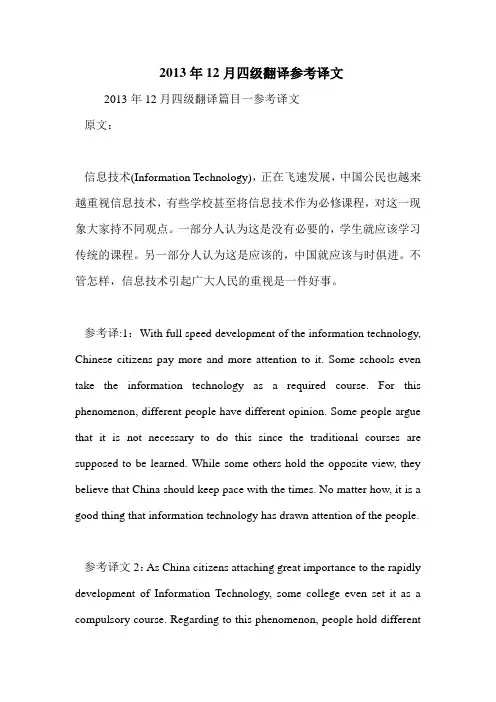
2013年12月四级翻译参考译文2013年12月四级翻译篇目一参考译文原文:信息技术(Information Technology),正在飞速发展,中国公民也越来越重视信息技术,有些学校甚至将信息技术作为必修课程,对这一现象大家持不同观点。
一部分人认为这是没有必要的,学生就应该学习传统的课程。
另一部分人认为这是应该的,中国就应该与时俱进。
不管怎样,信息技术引起广大人民的重视是一件好事。
参考译:1:With full speed development of the information technology, Chinese citizens pay more and more attention to it. Some schools even take the information technology as a required course. For this phenomenon, different people have different opinion. Some people argue that it is not necessary to do this since the traditional courses are supposed to be learned. While some others hold the opposite view, they believe that China should keep pace with the times. No matter how, it is a good thing that information technology has drawn attention of the people.参考译文2:As China citizens attaching great importance to the rapidly development of Information Technology, some college even set it as a compulsory course. Regarding to this phenomenon, people hold differentviews. Some people think it is not necessary, for students should learn the traditional curriculum. Another part of people think it is a need, because China should keep pace with the times. Anyway, it is a good thing that Information Technology aroused public concern.2013年12月四级翻译段落二参考译文原文:你要茶还是咖啡?是用餐人常被问到的问题。
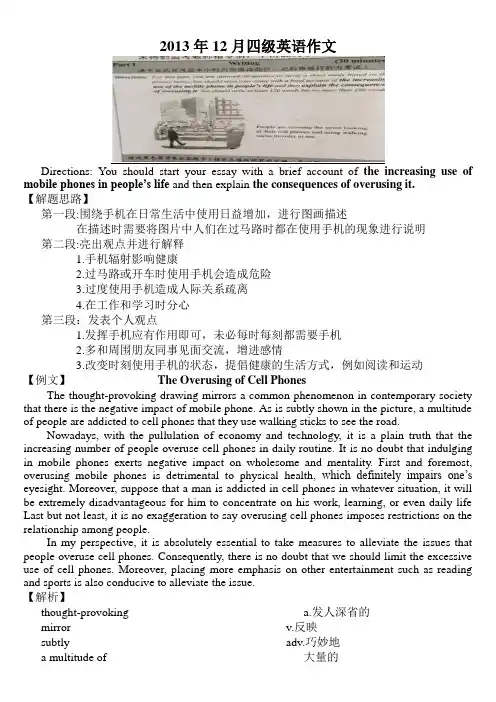
2013年12月四级英语作文Directions: You should start your essay with a brief account of the increasing use of mobile phones in people’s life and then explain the consequences of overusing it.【解题思路】第一段:围绕手机在日常生活中使用日益增加,进行图画描述在描述时需要将图片中人们在过马路时都在使用手机的现象进行说明第二段:亮出观点并进行解释1.手机辐射影响健康2.过马路或开车时使用手机会造成危险3.过度使用手机造成人际关系疏离4.在工作和学习时分心第三段:发表个人观点1.发挥手机应有作用即可,未必每时每刻都需要手机2.多和周围朋友同事见面交流,增进感情3.改变时刻使用手机的状态,提倡健康的生活方式,例如阅读和运动【例文】The Overusing of Cell PhonesThe thought-provoking drawing mirrors a common phenomenon in contemporary society that there is the negative impact of mobile phone. As is subtly shown in the picture, a multitude of people are addicted to cell phones that they use walking sticks to see the road.Nowadays, with the pullulation of economy and technology, it is a plain truth that the increasing number of people overuse cell phones in daily routine. It is no doubt that indulging in mobile phones exerts negative impact on wholesome and mentality. First and foremost, overusing mobile phones is detrimental to physical health, which definitely impairs one’s eyesight. Moreover, suppose that a man is addicted in cell phones in whatever situation, it will be extremely disadvantageous for him to concentrate on his work, learning, or even daily life Last but not least, it is no exaggeration to say overusing cell phones imposes restrictions on the relationship among people.In my perspective, it is absolutely essential to take measures to alleviate the issues that people overuse cell phones. Consequently, there is no doubt that we should limit the excessive use of cell phones. Moreover, placing more emphasis on other entertainment such as reading and sports is also conducive to alleviate the issue.【解析】thought-provoking a.发人深省的mirror v.反映subtly adv.巧妙地a multitude of 大量的with the pullulation of economy and technology 随着经济和科技的发展it is a plain truth that 一个明显的事实wholesome a.健全的be detrimental to 不利于definitely adv.清楚地impair vt.损害extremely adv.极其,非常it is no exaggeration to say 毫不夸张地说impose restrictions on 施加限制it is absolutely essential 完全有必要alleviate the issue 缓解问题【解题思路】第一段:围绕网络对人交流的影响,进行图画描述。
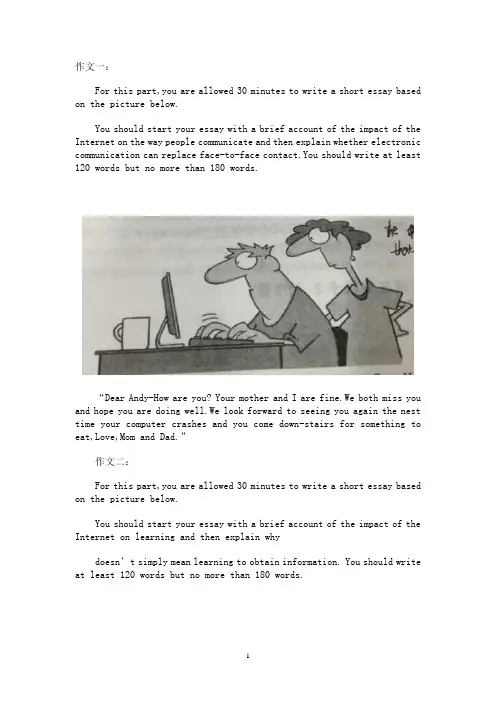
作文一:For this part,you are allowed 30 minutes to write a short essay based on the picture below.You should start your essay with a brief account of the impact of the Internet on the way people communicate and then explain whether electronic communication can replace face-to-face contact.You should write at least 120 words but no more than 180 words.“Dear Andy-How are you? Your mother and I are fine.We both miss you and hope you are doing well.We look forward to seeing you again the nest time your computer crashes and you come down-stairs for something to eat,Love,Mom and Dad.”作文二:For this part,you are allowed 30 minutes to write a short essay based on the picture below.You should start your essay with a brief account of the impact of the Internet on learning and then explain whydoesn’t simply mean learning to obtain information. You should write at least 120 words but no more than 180 words.“Once I learn how to use Google,isn’t that all the education I really need?”作文三:For this part,you are allowed 30 minutes to write a short essay based on the picture below.You should start your essay with a brief account of the increasin,use of the mobile phone in people’s life and explain theConsequence of overusing it. You should write at least 120 words but no more than 180 words.People are crossing the street looking at their cell phones and using walking sticks in order to see.Part II Listening Comprehension (30 minutes)Section ADirections:In this section,you will hear 8 short conversations and 2 long conversations.At the end of each conversation,one or more questions will be asked about what was said.Both the conversation and the questions will be spoken only once.After each question there will be a pause.During the pause,you must read the four choices marked A),B),C)and D),and decide which is the best answer,Then mark the corresponding letter on Answer Sheet 1 with a single line through the centre.注意:此部分试题请在答题卡1上作答。
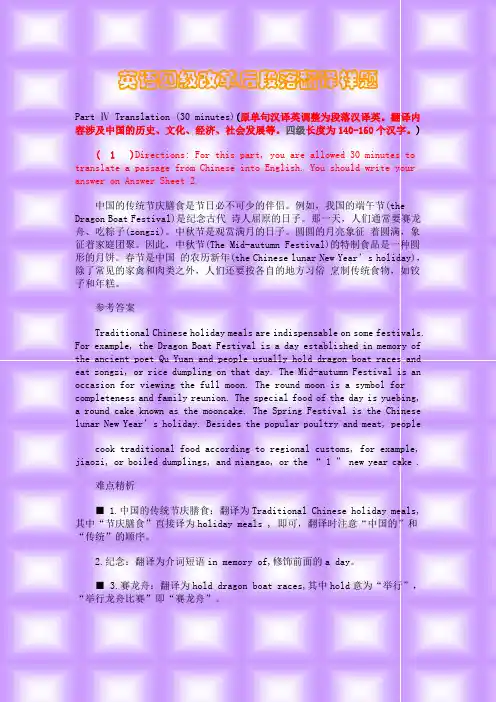
Part Ⅳ Translation (30 minutes)(原单句汉译英调整为段落汉译英。
翻译内容涉及中国的历史、文化、经济、社会发展等。
四级长度为140-160个汉字。
)( 1 )Directions: For this part, you are allowed 30 minutes to translate a passage from Chinese into English. You should write your answer on Answer Sheet 2.中国的传统节庆膳食是节日必不可少的伴侣。
例如,我国的端午节(the Dragon Boat Festival)是纪念古代诗人屈原的日子。
那一天,人们通常要赛龙舟、吃粽子(zongzi)。
中秋节是观赏满月的日子。
圆圆的月亮象征着圆满,象征着家庭团聚。
因此,中秋节(The Mid-autumn Festival)的特制食品是一种圆形的月饼。
春节是中国的农历新年(the Chine se lunar New Year’s holiday),除了常见的家禽和肉类之外,人们还要按各自的地方习俗烹制传统食物,如铰子和年糕。
参考答案Traditional Chinese holiday meals are indispensable on some festivals. For example, the Dragon Boat Festival is a day established in memory of the ancient poet Qu Yuan and people usually hold dragon boat races and eat zongzi, or rice dumpling on that day. The Mid-autumn Festival is an occasion for viewing the full moon. The round moon is a symbol for completeness and family reunion. The special food of the day is yuebing, a round cake known as the mooncake. The Spring Festival is the Chinese lunar New Year’s holiday. Besides the popular poultry and meat, peoplecook traditional food according to regional customs, for example, jiaozi, or boiled dumplings, and niangao, or the “ 1 ” new year cake .难点精析■ 1.中国的传统节庆膳食:翻译为Traditional Chinese holiday meals,其中“节庆膳食”直接译为holiday meals , 即可,翻译时注意“中国的”和“传统”的顺序。
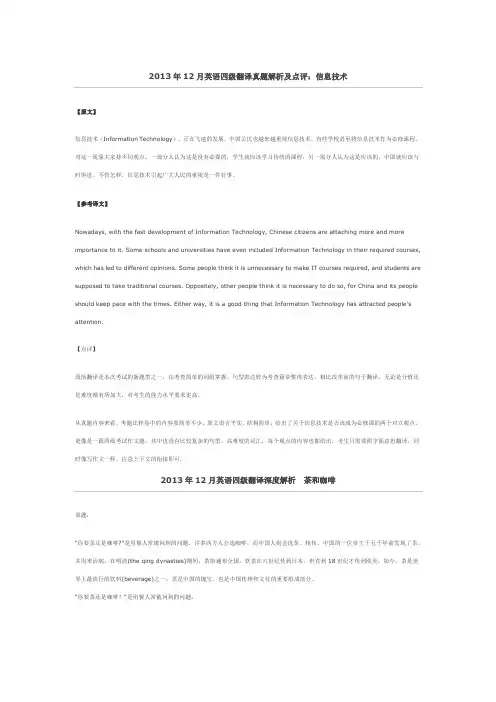
2013年12月英语四级翻译真题解析及点评:信息技术【原文】信息技术(Information Technology),正在飞速的发展,中国公民也越来越重视信息技术,有些学校甚至将信息技术作为必修课程,对这一现象大家持不同观点。
一部分人认为这是没有必要的,学生就应该学习传统的课程。
另一部分人认为这是应该的,中国就应该与时俱进。
不管怎样,信息技术引起广大人民的重视是一件好事。
【参考译文】Nowadays, with the fast development of Information Technology, Chinese citizens are attaching more and more importance to it. Some schools and universities have even included Information Technology in their required courses, which has led to different opinions. Some people think it is unnecessary to make IT courses required, and students are supposed to take traditional courses. Oppositely, other people think it is necessary to do so, for China and its people should keep pace with the times. Either way, it is a good thing that Information Technology has attracted people's attention.【点评】段落翻译是本次考试的新题型之一,由考查简单的词组掌握、句型表达转为考查篇章整体表达,相比改革前的句子翻译,无论是分值还是难度都有所加大,对考生的能力水平要求更高。
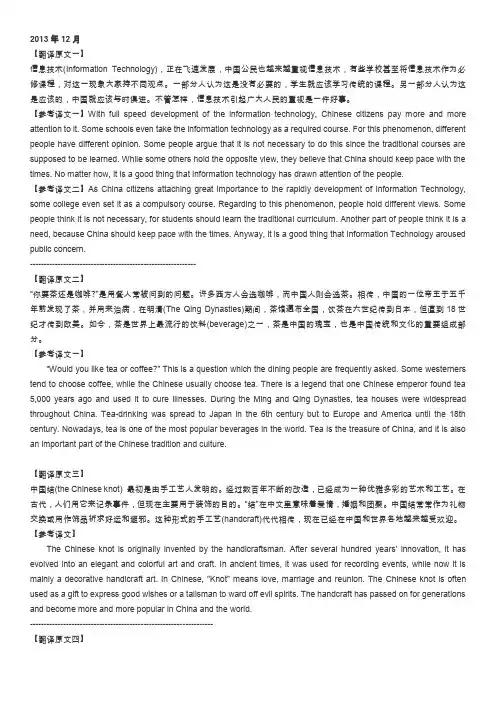
2013年12月【翻译原文一】信息技术(Information Technology),正在飞速发展,中国公民也越来越重视信息技术,有些学校甚至将信息技术作为必修课程,对这一现象大家持不同观点。
一部分人认为这是没有必要的,学生就应该学习传统的课程。
另一部分人认为这是应该的,中国就应该与时俱进。
不管怎样,信息技术引起广大人民的重视是一件好事。
【参考译文一】With full speed development of the information technology, Chinese citizens pay more and more attention to it. Some schools even take the information technology as a required course. For this phenomenon, different people have different opinion. Some people argue that it is not necessary to do this since the traditional courses are supposed to be learned. While some others hold the opposite view, they believe that China should keep pace with the times. No matter how, it is a good thing that information technology has drawn attention of the people.【参考译文二】As China citizens attaching great importance to the rapidly development of Information Technology, some college even set it as a compulsory course. Regarding to this phenomenon, people hold different views. Some people think it is not necessary, for students should learn the traditional curriculum. Another part of people think it is a need, because China should keep pace with the times. Anyway, it is a good thing that Information Technology aroused public concern.------------------------------------------------------------【翻译原文二】“你要茶还是咖啡?”是用餐人常被问到的问题。
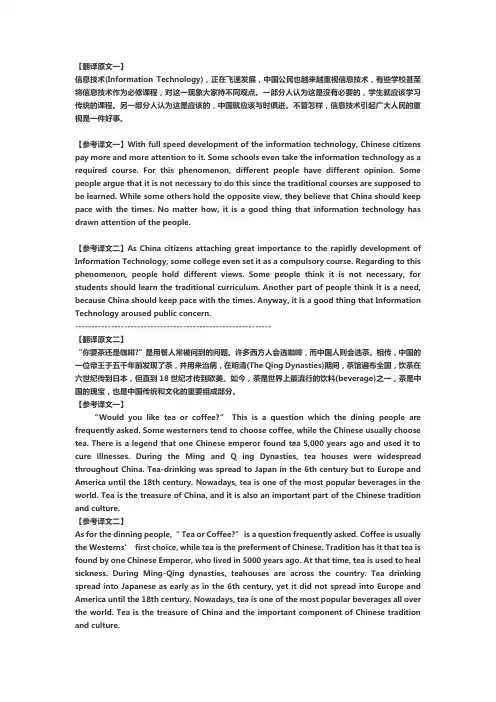
【翻译原文一】信息技术(Information Technology),正在飞速发展,中国公民也越来越重视信息技术,有些学校甚至将信息技术作为必修课程,对这一现象大家持不同观点。
一部分人认为这是没有必要的,学生就应该学习传统的课程。
另一部分人认为这是应该的,中国就应该与时俱进。
不管怎样,信息技术引起广大人民的重视是一件好事。
【参考译文一】With full speed development of the information technology, Chinese citizens pay more and more attention to it. Some schools even take the information technology as a required course. For this phenomenon, different people have different opinion. Some people argue that it is not necessary to do this since the traditional courses are supposed to be learned. While some others hold the opposite view, they believe that China should keep pace with the times. No matter how, it is a good thing that information technology has drawn attention of the people.【参考译文二】As China citizens attaching great importance to the rapidly development of Information Technology, some college even set it as a compulsory course. Regarding to this phenomenon, people hold different views. Some people think it is not necessary, for students should learn the traditional curriculum. Another part of people think it is a need, because China should keep pace with the times. Anyway, it is a good thing that Information Technology aroused public concern.------------------------------------------------------------【翻译原文二】“你要茶还是咖啡?”是用餐人常被问到的问题。
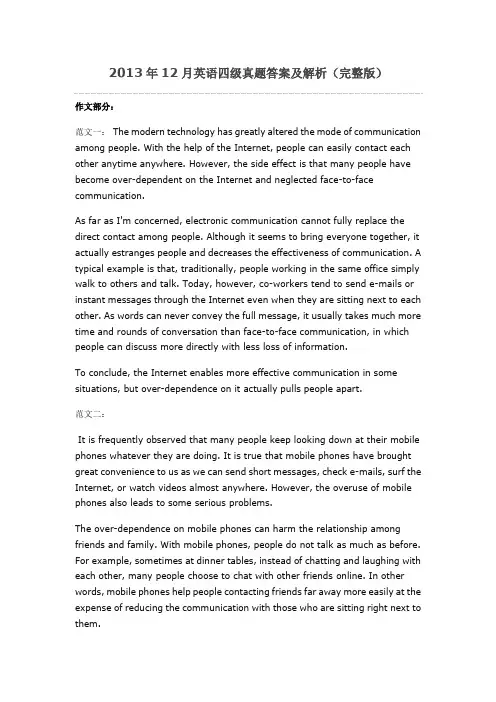
作文部分:范文一: The modern technology has greatly altered the mode of communication among people. With the help of the Internet, people can easily contact each other anytime anywhere. However, the side effect is that many people have become over-dependent on the Internet and neglected face-to-face communication.As far as I'm concerned, electronic communication cannot fully replace the direct contact among people. Although it seems to bring everyone together, it actually estranges people and decreases the effectiveness of communication. A typical example is that, traditionally, people working in the same office simply walk to others and talk. Today, however, co-workers tend to send e-mails or instant messages through the Internet even when they are sitting next to each other. As words can never convey the full message, it usually takes much more time and rounds of conversation than face-to-face communication, in which people can discuss more directly with less loss of information.To conclude, the Internet enables more effective communication in some situations, but over-dependence on it actually pulls people apart.范文二:It is frequently observed that many people keep looking down at their mobile phones whatever they are doing. It is true that mobile phones have brought great convenience to us as we can send short messages, check e-mails, surf the Internet, or watch videos almost anywhere. However, the overuse of mobile phones also leads to some serious problems.The over-dependence on mobile phones can harm the relationship among friends and family. With mobile phones, people do not talk as much as before. For example, sometimes at dinner tables, instead of chatting and laughing with each other, many people choose to chat with other friends online. In other words, mobile phones help people contacting friends far away more easily at the expense of reducing the communication with those who are sitting right next to them.In conclusion, mobile phone can be a useful tool in modern life, but overusing it damages interpersonal relationship. There is no point to lose our intimacy with friends and family to modern technology.范文三:The impact of the Internet on learningExplain why education doesn’t simply mean learning to obtain informationIn the age of knowledge explosion, the Internet opens a magical portal for leaners to get access to seemingly incessant information. But is information equal to knowledge? “Once I learn how to use google, isn't that all the education I really need?” This question fully embodies the prejudiced opinion that as long as people acquire abundant information, they will get proper education.The rea son why education doesn’t simply mean learning to obtain information is that education is not limited to the hard facts or theories students can learn from their textbooks or the Internet. It relates to a wider scope ranging from the obtainment of practical skills to the development of characters, which are hard for students to learn simply by googling. Consequently, comprehensive learning in schools that includes learning knowledge, conducting experiments and communicating with peers is what true education is.In a word, the Internet does provide valuable information for learners, but people should be fully conscious of the essence of education and learn to tell the right from the wrong.听力部分:1. C. Consult a travel agent.2. A. They are on a long trip by car.3. C. He is unwilling to speak in public.4. B. Purse further education.5. A. He would not be available to start the job in time.6. B. Mechanic.7. D. Ask Laura to put off the cleaning until another week.8. A. A problem caused by the construction.9. C. To place an order for some products.10. A. The person in charge is not in the office.11. B. 0734, 21653 extension 51.12. B. Since he took to heavy smoking.13. A. He is getting too fat.14. D. They dislike doing physical exercise.15. C. To find a girlfriend.16-19音频无。
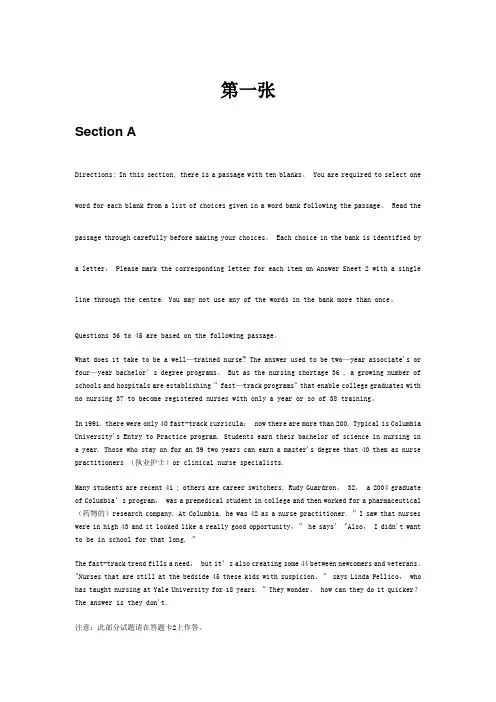
第一张Section ADirections: In this section, there is a passage with ten blanks。
You are required to select one word for each blank from a list of choices given in a word bank following the passage。
Read the passage through carefully before making your choices。
Each choice in the bank is identified by a letter, Please mark the corresponding letter for each item on Answer Sheet 2 with a single line through the centre. You may not use any of the words in the bank more than once。
Questions 36 to 45 are based on the following passage。
What does it take to be a well—trained nurse? The answer used to be two—year associate's or four—year bachelor’s degree programs。
But as the nursing shortage 36 , a growing number of schools and hospitals are establishing ”fast—track programs" that enable college graduates with no nursing 37 to become registered nurses with only a year or so of 38 training。
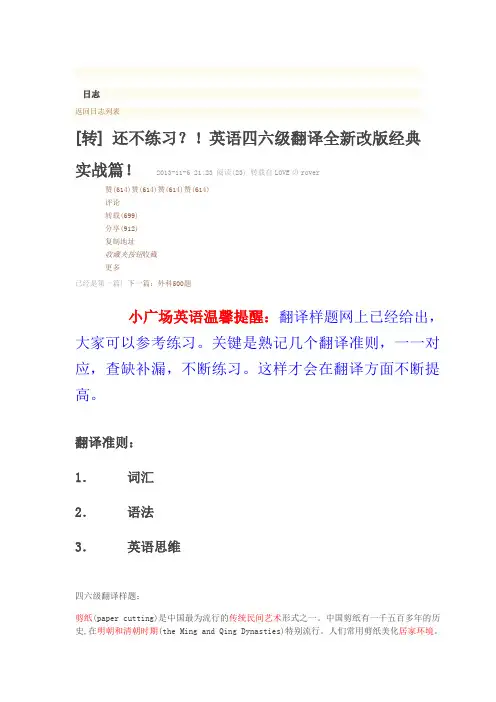
日志返回日志列表[转] 还不练习?!英语四六级翻译全新改版经典实战篇!2013-11-6 21:23阅读(23)转载自LOVEのrover赞(614)赞(614)赞(614)赞(614)评论转载(699)分享(912)复制地址收藏夹按钮收藏更多已经是第一篇| 下一篇:外科500题小广场英语温馨提醒:翻译样题网上已经给出,大家可以参考练习。
关键是熟记几个翻译准则,一一对应,查缺补漏,不断练习。
这样才会在翻译方面不断提高。
翻译准则:1.词汇2.语法3.英语思维四六级翻译样题:剪纸(paper cutting)是中国最为流行的传统民间艺术形式之一。
中国剪纸有一千五百多年的历史,在明朝和清朝时期(the Ming and Qing Dynasties)特别流行。
人们常用剪纸美化居家环境。
特别是在春节和婚庆期间,剪纸被用来装饰门窗和房间,以增加喜庆的气氛。
剪纸最常用的颜色是红色,象征健康和兴旺。
中国剪纸在世界各地很受欢迎,经常被用作馈赠外国友人的礼物。
参考译文:Paper cutting is one of most popular traditional folk arts in China. Chinese paper cutting has a history of more than 1,500 years. It was widespread particularly during the Ming and Qing Dynasties. People often beautify their homes with paper cuttings. During the Spring Festival and wedding celebrations, in particular, paper cuttings aroused to decorate doors, windows and rooms in order to enhance the joyous atmosphere. The color most frequently used in paper cutting is red, which symbolizes health and prosperity. Chinese paper cutting is very popular around the world and it is often given as a present to foreign friends.以下是我们总结的几大翻译话题,供大家参考练习一、京剧Peking Opera京剧,号称东方歌剧,是地道的中国国粹,可以追溯到1790年。
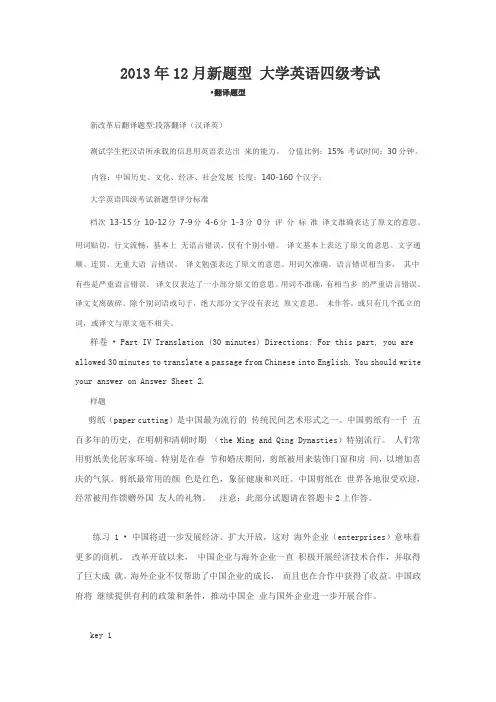
2013年12月新题型大学英语四级考试•翻译题型新改革后翻译题型:段落翻译(汉译英)测试学生把汉语所承载的信息用英语表达出来的能力。
分值比例:15% 考试时间:30分钟。
内容:中国历史、文化、经济、社会发展长度:140-160个汉字;大学英语四级考试新题型评分标准档次13-15分10-12分7-9分4-6分1-3分0分评分标准译文准确表达了原文的意思。
用词贴切,行文流畅,基本上无语言错误,仅有个别小错。
译文基本上表达了原文的意思。
文字通顺、连贯,无重大语言错误。
译文勉强表达了原文的意思。
用词欠准确,语言错误相当多,其中有些是严重语言错误。
译文仅表达了一小部分原文的意思。
用词不准确,有相当多的严重语言错误。
译文支离破碎。
除个别词语或句子,绝大部分文字没有表达原文意思。
未作答,或只有几个孤立的词,或译文与原文毫不相关。
样卷• Part IV Translation (30 minutes) Directions: For this part, you are allowed 30 minutes to translate a passage from Chinese into English. You should write your answer on Answer Sheet 2.样题剪纸(paper cutting)是中国最为流行的传统民间艺术形式之一。
中国剪纸有一千五百多年的历史,在明朝和清朝时期(the Ming and Qing Dynasties)特别流行。
人们常用剪纸美化居家环境。
特别是在春节和婚庆期间,剪纸被用来装饰门窗和房间,以增加喜庆的气氛。
剪纸最常用的颜色是红色,象征健康和兴旺。
中国剪纸在世界各地很受欢迎,经常被用作馈赠外国友人的礼物。
注意:此部分试题请在答题卡2上作答。
练习 1 • 中国将进一步发展经济、扩大开放,这对海外企业(enterprises)意味着更多的商机。
改革开放以来,中国企业与海外企业一直积极开展经济技术合作,并取得了巨大成就。
2013年12月英语四级真题作文一:For this part,you are allowed 30 minutes to write a short essay based on the picture below. You should start your essay with a brief account of the impact of the Internet on the way people communicate and then explain whether electronic communication can replace face-to-face contact.You should write at least 120 words but no more than 180 words.“Dear Andy-How are you? Your mother and I are fine.We both miss you and hope you are doing well.We look forward to seeing you again the nest time your computer crashes and you come down-stairs for something to eat,Love,Mom and Dad.”作文二:For this part,you are allowed 30 minutes to write a short essay based on the picture below. You should start your essay with a brief account of the impact of the Internet on learning and then explain whydoesn’t simply mean learning to obtain information. You should write at least 120 words but no more than 180 words.-“Once I learn how to use Google,isn’t that all the education I really need?”作文三:For this part,you are allowed 30 minutes to write a short essay based on the picture below. You should start your essay with a brief account of the increasin,use of the mobile phone in people’s life and explain theConsequence of overusing it. You should write at least 120 words but no more than 180 words.People are crossing the street looking at their cell phones and using walking sticks in order to see.Part II Listening Comprehension (30 minutes)Section ADirections:In this section,you will hear 8 short conversations and 2 long conversations.At the end of each conversation,one or more questions will be asked about what was said.Both the conversation and the questions will be spoken only once.After each question there will be a pause.During the pause,you must read the four choices marked A),B),C)and D),and decide which is the best answer,Then mark the corresponding letter on Answer Sheet 1 with a single line through the centre.-注意:此部分试题请在答题卡1上作答。
2013年12月大学英语四级真题及答案解析汇总一、作文【作文(一)】The Impact of the Mobile Phone in People’s LifeThe thought-provoking drawing mirrors a common phenomenon in contemporary society that there is the negative influence of mobile phone. As is subtly shown in the picture,so many people are too much addicted to cell phones that they use walking sticks to see the road. What a meaningful cartoon!It is to me that indulging in mobile phones produces native influences on body and mind. First and foremost, overusing mobile phones is detrimental to physical health for watching mobiles for a long stretch definitely impairs one’s eyesight. Suppose that a man is addicted in cell phones in whatever situation, it will be very disadvantageous for him to concentrate on his work, learning, or daily life and is very likely to hurt him. Furthermore, overusing cell phones adversely affects state of mind. An addict may stay inside his bubble instead of pursuing other endeavors, which eventually prevents the growth of think skills.It is high time that we took effective measures to curb this trend. I cherish a belief that cell phones themselves are not good or bad and we can benefit a lot from it as long as we take a good control over them.【作文(二)】The Impact of the Internet on the Way People Communicate网络对人们沟通产生的影响Internet does exert such a profound effect on our life that it revolutionizes the way of people’s living and thinking. As is subtly revealed in the portrayal,there are two parents sitting in the front of computer,who are chatting with their child on the internet. What a meaningful picture!From my perspective, the electronic contact cannot replace face to face communication owing to the following factors. To begin with, over-reliance on electronic contact will damage the interpersonal relationship, for the cold machine never replaces a warm-hearted greeting face to face. For example, the aged parents would like their only son who works far away home to come back home more often rather than to talk with him on the internet occasionally. What’s more, face to face communication is preferable because it is beneficial to build a harmonious society, for it attaches more importance on human affection and feelings instead of convenience and speed.Hence, it is necessary for us to use Internet in a reasonable way. After all, Internet isinvented to connect you and me, and to bring conveniences to our life rather than set a barrier to keep people beyond reach. If we want to keep our interpersonal relationship more effectively, we should spend more time with them face to face in real life. Only in this way can we not only make full use of the communication tool on the net but also make our relationship tighter.二、听力测试【四级听力短对话】Question 1M: After high school, I’d lik e to go to college and major in business administration.W: But I’d rather spend my college days finding out how children learn.Q: What do we learn from the conversation?Question 2W: Is everything ready for the conference?M: The only thing left to do is set up the microphones and speakers. They'll be here in a few minutes.Q: What preparations have yet to be made?Question 3W: Is it almost time to go home now? I'm so tired. I can hardly see straight.M: Just a few more minutes, then we can go.Q: What is the woman’s problem?Question 4W: I'm not sure what I’m in a mood for. Ice-cream or sandwiches? They are both really good here.M: The movie starts in an hour. And we still have to get there and park. So just make a decision.Q: What does the man mean?Question 5W: Tom said he would come to repair our solar heater when he has time.M: He often says he is willing to help, but he never seems to have time.Q: What does the man imply about Tom?Question 6W: So you know that Sam turns down the job offered by the travel agency.M: Yes. The hours were convenient. But if he had accepted it, he wouldn’t be able to make ends meet.Q: What do we learn from the conversation?Question 7M: Could you tell me a bit about the business your company is doing?W: We mainly deal with large volume buyers from western countries and our products have been well received.Q: What business is the woman’s company doing?Question 8W: Yesterday I made reservations for my trip to Miami next month.M: You must really be looking forward to it. You haven’t had any time off for at least two years.Q: What is the woman going to do?【四级听力长对话原文1】M: Excuse me, I need some information about some of the towns near here.W: What would you like to know?M: Well, first, I'd like directions to go to Norwalk. I believe there is an interesting museum there. It isn't far, is it?W: No, not at all. Norwalk is about eighteen miles east of here on Route 7. And you're right. It's a wonderful little museum.M: Oh good. Now what about Amitsville? I have some friends. I'd like to visit there and I also want to get to Newton. They are near each other, aren't they?W: Hmm... well, they are actually in opposite directions. Amitsville is northeast. It's about thirty five miles northeast of here.M: Huh-uh, thirty five miles northeast. And how about Newton?W: Well, Newton is in the other direction. It's southwest, so it isn't really very close to Amitsville at all and it's a long drive. It's about fifty five miles southwest from here and the road is not at all straight.M: Fifty five miles southwest! Well, maybe I won't go there this time.W: I'd recommend visiting Westfield or Great Town. They are both very close. Westfield is just seven miles west of here and Great Town is about five miles south. They are really pretty little towns with lots of old houses and beautiful tree-lined streets.M: I see. Seven miles west to Westfield and five miles south to Great Town. Good. Well, I think that's all the information I need for a while. Thank you. You've been very helpful.W: You're welcome, sir. I hope you enjoy your stay.Q9: What does the man know about Norwalk?Q10: What does the woman say about Amitsville and Newton?Q11: What do we learn about Westfield and Great Town?【四级听力长对话原文2】M: Err... Sandra, I've finished with Mr. Gordon now. Do you think you could pop through in bringing me up-to-date on their arrangements for the Italian trip?W: Certainly, Mr. Wilkinson. I'll bring everything with me.M: Right, take a seat. Now my first meeting is when?W: Your first meeting is on Monday the 21st at 9a.m. with Dr. Gucci of Bancos en Piedra in Milan.M: OK, so can I fly out early Monday morning?W: Well, there is a flight to Lenarty Airport which leaves at six thirty London time and gets in at eight thirty Italian time.M: Yeah, but that only leaves me thirty minutes to clear customs in getting to the city center and it means I have to check in by five thirty, which means leaving home at about four fifteen.W: I'm afraid so.M: Hmm... not so keen on that. What's the program for the rest of that day?W: It's quite full, I'm afraid. At eleven, you're seeing Jeana Rivard at Meg Star and then you'll have a lunch engagement with Gaven from the Chamber of Commerce at one.M: Where's that?W: You're meeting him at his office and then he's taking you somewhere.M: Good, that sounds fine. What about the afternoon?W: Well, at three thirty, you're seeing our sales representative there and then you're free till evening.M: I see. I seem to remember that I'm having a dinner with someone from Bergamo.W: That's right. And Mr. Betty from SAP Industries at eight.Q12: What would the man like the woman to do?Q13: At what time is Mr. Wilkinson going to leave home for the airport?Q14: Who is Mr. Wilkinson going to have a lunch with on Monday?Q15: What is most probably the woman's job?【听力短文】Listening Passage 1Donna Fredrick’s served with the Peace Corps for two years in Brazil. She joined the Peace Corps after she graduated from the college because she wanted to do something to help other people. She had been brought up on a farm, so the Peace Corps assigned her to a agricultural project. Before she went to Brazil, she studied Portuguese for three months. She also learnt a great deal about its history and culture. During her two years with the Peace Corps, Donna lived in a village in northeast Brazil. That part of Brazil is very dry and farming is often difficult there. Donna helped the people of the village to organise an arrigation project, and she also advised them on planting corps. They didn’t require much water. When Donna returned to the States, she couldn’t settle down. She tried several jobs, but they seemed very boring to her. She couldn’t get Brazil out of her mind. Finally, one day she got on an plane and went back to Brazil. She wasn’t sure what she’s going to do. She just wanted to be there. After a few weeks, Donna found a job as an English te acher, teaching five classes a day. Like most of the teachers, she doesn’t make much money. She shares a small apartment with another teacher. And she makes a little extra money by sending stories to newspapers in the States. Eventually she wants to quit teaching andwork as a full-time journalist.Question 16Why did Donna join the Peace Corps after she graduated from college?Question 17What was Donna assigned to do in Brazil?Question 18Why did Donna go back to Brazil once again?Question 19How did Donna make extra money to support herself?Listening Passage 2Results of a recent Harry’s pool on free time showed that the average work week for many Americans is 50 hours. With the time spent eating, sleeping and taking care of the household duties, there’s little time left for leisure activities for many Americans. However, having free time to relax and pursue hobbies is important. People need time away from the pressures of study or work to relax and enjoy time with friends and family. In many countries free time is spent in different ways. The results of a Harry’s pool showed that reading was the most popular spare time activity in the US. This was followed by watching TV. In a UK survey on leisure time activities, watching TV and videos was the most popular. Listening to the radio came second. In a similar survey conducted in Japan, the most popular free time activity was eating out. The second most popular activity was driving. There were also differences in the most popular outdoor pursuits between the three countries. The most popular outdoor activity for Americans was gardening. In the UK, it was going to the pub. In Japan, going to bars ranked eighth in popularity and gardening ranked ninth. Although people around the world may enjoy doing similar things in their free time, there’s evidence to suggest that these interests are changing. In the US, for example, the popularity of computer activities is increasing. Many more people in the States are spending their free time surfing the web, emailing friends or playing games online.Question 20What is the recent Harry Pole about?Question 21What was the most popular leisure activity in the US?Question 22What was the most popular outdoor pursuit in the UK?Listening Passage 3On March 13th, while on duty Charles Mclaughlin, a very careless driver employed by the company Lummis was involved in another accident. The accident occurred in Riverside California. Not paying attention to his driving, Mclaughlin turned right on main street and 33rd street and hit Volkswagen rabbit. This caused minor damage to his truck and serious damage to the car. On the basis of the police report, the Lummis accident committee correctly determined that Mclaughlin had been quite careless. As a result of the committee’s conclusion, the branch manager Mr. David Rossi reported that he had talked with Mclaughlin about his extremely poor driving record. Further evidence of Mclaughlin's irresponsibility occurred on May 6th when he was returning from his shift. That day he ran into a roll-up door at the Lummis facility in Valero, causing significant damage to the door. Damage to the truck, however, was minor. Finally, on June 7th, Mclaughlin once again demonstrated his carelessness by knocking down seve ral mail boxes near the edge of the company’s parking lot. There was damage to the mailboxes and minor damage to the truck. Mr. David Rossi stated that he had spoken with Mclaughlin on several occasions about his driving record. He added that he had warned Mclaughlin that three preventable accidents in one year could lead to his discharge, as indeed it should.23. What did the Lummis accident committee find out about the accident that occurred on March 13th?24. What did Mclaughlin do on June 7th near t he edge of the company’s parking lot?25. What is most probably going to happen to Mclaughlin?【听力填空】:When Captain Cook asked the chiefs in Tahiti why they always ate apart and alone, they replied, “Because it is right.” If we ask Americans why they eat with knives and forks, or why their men wear pants instead of skirts or why they may be married to only one person at a time, we are likely to get similar and very uninformative answers because it’s right, because that’s the way it’s done, because it’s the custom or even I don’t know. The reason for these and countless other patterns of social behavior is that they are controlled by social norms shared rules or guide lines which prescribe the behavior that is appropriate in a given situation. Norms define how people ought to behave under particular circumstances in a particular society. We conform to norms so readily that we are hardly aware they exist. In fact we are much more likely to notice departures from norms than conformity to them. You will not be surprised if a stranger tried to shake hands when you were introduced, but you might be a little startled if they bowed, started to stroke you or kissed you on both cheeks. Yet each of these other forms of greeting is appropriate in other parts of the world. When we visit another society whose norms are different, we quickly become aware that things we do this way, they do that way.听力参考答案1-8 CACBA BDA9-11 CAB12-15 DADC16-19 暂无20-22 DAC23-25 ABD26-35 In addition; software; available; individuals; technological; manufacture; In short; By contrast; scientific; quantity三、选词填空【版本一】36. worsens37. experience38. specialized39. additional40.qualifies41. graduates42. trained43. demand44. tension45. view【版本二】36-45 N site、L rare、I honoring、F different、D current、C covers、J hope、M realistic、H fast四、阅读理解【长篇阅读】46-55 kcebh djclf【仔细阅读】第一篇56-60 cadcd 第二篇61-65abdbc五、翻译【翻译原文一】信息技术(Information Technology),正在飞速发展,中国公民也越来越重视信息技术,有些学校甚至将信息技术作为必修课程,对这一现象大家持不同观点。
英语四级翻译真题及范文答案(2017-12)-CAL-FENGHAI-(2020YEAR-YICAI)_JINGBIAN2013年12月大学英语四级考试翻译题目许多人喜欢中餐,在中国,烹饪不仅被视为一种技能,而且也被视为一种艺术。
精心准备的中餐既可口又好看,烹饪技艺和配料在中国各地差别很大。
但好的烹饪都有一个共同点,总是要考虑到颜色、味道、口感和营养(nutrition)。
由于食物对健康至关重要,好的厨师总是努力在谷物、肉类和蔬菜之间取得平衡,所以中餐既味美又健康。
Most people like Chinese food. In China, cooking is considered as not only a skill but also an art. The well-prepared Chinese food is both delicious and good-looking. Although cooking methods and food ingredient vary wildly in different place s of China, it is common for good cuisine to take color, flavor, taste and nutrition into account. Since food is crucial to health, a good chef is insistently trying to seek balan ce between cereal, meat and vegetable, and accordingly Chinese food is delicious as well as healthy.信息技术(Information Technology),正在飞速发展,中国公民也越来越重视信息技术,有些学校甚至将信息技术作为必修课程,对这一现象大家持不同观点。
第一版:【翻译原文】信息技术(Information Technology),正在飞速的发展,中国公民也越来越重视信息技术,有些学校甚至将信息技术作为必修课程,对这一现象大家持不同观点。
一部分人认为这是没有必要的,学生就应该学习传统的课程。
另一部分人认为这是应该的,中国就应该与时俱进。
不管怎样,信息技术引起广大人民的重视是一件好事。
【参考译文】Nowadays, with the fast development of Information Technology, Chinese citizens are attaching more and more importance to it. Some schools and universities have even included Information Technology in their required courses, which has led to different opinions. Some people think it is unnecessary to make IT courses required, and students are supposed to take traditional courses. Oppositely, other people think it is necessary to do so, for China and its people should keep pace with the times. Either way, it is a good thing that Information Technology has attracted people's attention.第二版:【翻译原文】“你要茶还是要咖啡?”是用餐人常被问到的题目,许多西方人会选咖啡,而中国人会选茶。
试卷一:中餐【真题原文】许多人喜欢中餐,在中国,烹饪不仅被视为一种技能,而且也被视为一种艺术。
精心准备的中餐既可口又好看,烹饪技艺和配料在中国各地差别很大。
但好的烹饪都有一个共同点,总是要考虑到颜色、味道、口感和营养(nutrition)。
由于食物对健康至关重要,好的厨师总是努力在谷物、肉类和蔬菜之间取得平衡,所以中餐既味美又健康。
【翻译答案】Many people like Chinese food. In China, cooking is viewed as not only a skill but also a form of art. The well-prepared Chinese food is both delicious and good-looking. Although cooking methods and food ingredients vary wildly in different places of China, it is common for good cuisine to take color, flavor, taste and nutrition into account. Since food is crucial to health, a good chef is insistently trying to seek balance between cereal, meat and vegetable, and accordingly Chinese food is delicious as well as healthy.试卷二:信息技术【真题原文】信息技术(Information Technology),正在飞速发展,中国公民也越来越重视信息技术,有些学校甚至将信息技术作为必修课程,对这一现象大家持不同观点。
一部分人认为这是没有必要的,学生就应该学习传统的课程。
剪纸(papercutting)是中国最为流行的传统民间艺术形式之一。
中国剪纸有一千五百多年的历史,在明朝和清朝时期(the Ming and Qing Dynasties)特别流行。
人们常用剪纸美化居家环境。
特别是在春节和婚庆期间,剪纸被用来装饰门窗和房间,以增加喜庆的气氛。
剪纸最常用的颜色是红色,象征健康和兴旺。
中国剪纸在世界各地很受欢迎,经常被用作馈赠外国友人的礼物。
参考译文:Paper cutting is one of most popular traditional folk arts in China. Chinese paper cutting has a history of more than 1,500 years. It was widespread particularly during the Ming and Qing Dynasties. People often beautify their homes with paper cuttings. During the spring Festival and wedding celebrations, in particular, paper cuttings are used to decorate doors, windows and rooms in order to enhance the joyous atmosphere. The color most frequently used in paper cutting is red, which symbolizes health and prosperity. Chinese paper cutting is very popular around the world and it is often given as a present to foreign friends.以下是我们总结的几大翻译话题,供大家参考练习一、京剧Peking Opera京剧,号称东方歌剧,是地道的中国国粹,可以追溯到1790年。
那年,4个徽剧戏班子奉诏进京表演。
京剧的一大特点是在人物的脸上涂上各种颜色,以象征这个人物的性格和品质。
简单的讲,红脸含有褒义,代表忠勇;黑脸代表智慧;蓝脸和绿脸代表草莽英雄;黄脸和白脸代表奸诈;金脸和银脸代表神秘或超自然力量。
现如今,京剧也成了颇受人们欢迎的艺术形式之一,广受推崇。
Peking Opera,known as the Eastern Opera,is a purely one of best parts of Chinese culture,it can dates back to the year of 1790. In that year,four local opera troupes of Anhui province came to Beijing on a performance tour. For the painted roles, a special feature of Peking Opera, the different colors of the faces represent different characters and personalities. Generally, red stands for uprightness and loyalty, black means wisdom, blue and green indicate the vigorous and rebellious heroes,yellow and white represent cunning and gold and silver represent mystic or super-natural power.Nowadays, Peking Opera has became one of the most popular arts among people and widespread all over the country.二、丝绸之路The Silk Road丝绸之路实际上是很多条中国通往古罗马商路的总称。
古代丝绸之路的起点是中国当时的古都长安(现在的西安),终点在地中海东岸,几乎有一半路程穿越新疆。
丝绸之路始于汉武帝时期,不仅是佛教进入中国的通道,而且路上商旅往来络绎不绝。
元朝时,丝绸之路逐渐被日益繁荣的海上贸易所取代。
丝绸之路还是一条友谊之路,在政治、经济、文化方面发挥了纽带的作用。
The Silk Road is the joint name given to a number of trade routes linking China and ancient Rome. The ancient silk road had its start in Chang’an(now Xi’an), the capital of then China, and its terminus on the eastern coast of the Mediterranean, with nearly half of it running across Xinjiang. The Silk Road began during the time of emperor Wudi of the Han dynasty, is not only an important route for Buddhism to enter china, but also an endless stream of merchants and business travelers. In the Yuan dynasty, the silk road gradually gave the way to the rapidly developing sea trade. The Silk Road was also a road of friendship, linking the west and the east economically,politically and culturally.三、中国新年Chinese New Year中国的新年,又称春节。
这是合家欢聚的日子,家里人都要赶回来,就像西方的圣诞节一样。
不过,我们是在农历的一月一日过新年,一般会比阳历晚一个月。
过年的时候,小辈们先向父母和祖父母祝贺新年快乐,之后就会收到红包。
我们还可以在见面的时候互相说:“恭喜发财,新年快乐,生意兴隆”等问候语以衬托过年喜庆的节日气氛。
The Chinese New Year, also called the spring festival, is an occasion of reunion for family members. The same thing happen in the west for the Christmas. However, the Chinese New Year falls on the January 1stof the lunar calendar, which comes usually later than the same date of the Gregorian calendar. There is money in the red envelop, given by parents and grand parents to kids as New Year gift after they wish the eldersa happy new year. We also can deliver some words like “wish you a good fortune,wishyou a happy new year,wish you a prosperous business” to add the joyous atmosphere for the spring festival.四、中国少数民族中国是一个统一的多民族国家,有56个民族。
目前,中国共有55个少数民族,人口一亿多,占全国总人口的12%左右;民族自治地区面积超过600万平方公里,占国土总面积的64.2%。
由于独特的自然环境,社会条件和经济发展水平,我国各民族人民发展了各自独特的风俗习惯,包括饮食、服饰和礼仪。
一般来说,汉族人主食喜欢吃大米、白面,吃蔬菜、豆类及鱼肉蛋,并十分注重烹调艺术。
China is a unified multi-ethnic country with 56 ethnic nationalities. More than 100 million of population, or about 12 percent of China’s total population are from 55 ethnic minorities. Ethnic autonomous regions cover over 6 million square km, making up 64.2 percent of China’s territory. China’s different peoples have developedindividual customs regarding food, clothing and etiquette, in response to their own particular environments, social conditions and levels of economic development.Generally, the Han people take rice and flour as their staple diet, love to eatvegetables, beans, meat, fish and eggs, and pay particular attention to the art ofcooking.五、工艺品中国的民间手工艺有很悠久的历史。
首当其冲的就是玉,在中国,玉器有七八千年的历史。
公元前3,500年左右开始,中国就有玉雕工艺了。
常见的玉器有花、鸟、兽和人物,特别是传说里漂亮的仙女。
还有很多别的工艺品,比如各种各样的刺绣、地毯、泥人儿和面人儿、剪纸、风筝、彩灯等等。
为了继承和发扬我国优秀的传统工艺,全国成立了两百多所专门的工艺美术学院和职业学校。